Stonehenge, England.
Stonehenge Facts And Hypotheses. Legends.
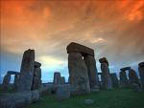 Stonehenge is a majestic building of gigantic stone blocks, built four thousand years ago on the Solsbery plain of the British Isles. The convincing arguments are already got that Stonehenge was utilized as an astronomic observatory which allowed to determine the change of the seasons of the year, and also the solar and lunar eclipses.
Stonehenge is a majestic building of gigantic stone blocks, built four thousand years ago on the Solsbery plain of the British Isles. The convincing arguments are already got that Stonehenge was utilized as an astronomic observatory which allowed to determine the change of the seasons of the year, and also the solar and lunar eclipses.
Enormous ruins keep their secret. Will we get news, brought by them from the incredible depths of millenniums? Or, maybe, the humanity is appointed to think about the solution of the message left us by the unknown civilization?
Legends, history of Stonehenge
"If you are inclined to think that the life is shallow and soon we’ll get to basis of all essence, these ancient stones, grey columns will remind us of the immeasurable depth of Time".
In the whole world there is nothing of the kind of these severe ruins which “are in history so lonely, as well as on their boundless plain". What was this gigantic and silent building? For what was, this monument, created by those, from whom there were no more tracks on earth served? The an answer on this question is unknown, yet though people took an interest on it from ancient times. Stonehenge is so old, that already in antiquity its real history was forgotten. This place always was surrounded by legends and stories, every epoch tried to explain its riddle in its own way.

Legends talk that once Uther Pandragon, the legendary father of King Arthur, appeared in Solisbury, "where earls and princes were buried", and he became "thoughtful how to honour better this place the green turf of which covered so many noble warriors". A magician Merlin advised him: "If you wish to adorn the grave of these people worthy, to mark it forever, send people for Tank of Giants, in Killaros on the mountain in Ireland. At present nobody would determine these stones, if only his mind will not be so large as this art. Because these enormous stones, and nowhere there are others, endowed with equal force, and that is why, they are set in a ring circle near this place, where they stand at present and they will stand here to the end of ages".
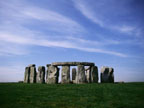 Uther began to laugh and said: "But why to drive stone so enormous from so far country, as though in Britain they will not find the stones for such business?"
Uther began to laugh and said: "But why to drive stone so enormous from so far country, as though in Britain they will not find the stones for such business?"
Merlin answered: "Not laugh, not thinking… a secret is hidden in these stones. Giants in antiquity had brought them from distant lands of Africa, and set them in Ireland in those times, when they lived there. and there is not among them a stone not endowed with witchcraft force". Merlin convinced the king, and in one night with the help of the "magic word" and magic force he carried these stones to Britain.
It was considered in the 17-th century, that Stonehenge was devoted to the glory of British Queen Boudica, who led the uprising against Rome. They Proclaimed the majestic ruins both "an Old British triumphal temple in honour of Anarait, their goddess of victory", and "a giant building, erected by danes in order to be a royal court or a place for elections and coronation of their kings".
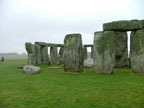
It was carried out in that epoch, probably, in all history the first careful inspection of the building by John Aubrey. He examined a monument, and came to a conclusion, that these old stones had been the temple of druids.
Stonehenge, as well as all other circular structures of stones, was a "snakes’ temple", or "Dragontiy". Legends, guess-works, versions, about an origin and value of Stonehenge continue to multiply. At the beginning of the 20-th century serious archaeological researches of the monument were carried out. The history of Stonehenge was no less interesting. The stone blocks of many tons were delivered, processed and set with enormous exactness which striked researchers.
Stonehenge facts and hypotheses.
In the 70ies of our century an astronomer Gerald Khokins, native of England, made a discovery which became a stride in solution of the secret of Stonehenge, England. He was the first who wrote in his works that, this building was the oldest observatory. The subsequent development of this theory showed that unknown builders had owned the deep knowledge in astronomy and mathematics.
 Compound as a whole complex of astronomical instruments, and at the same time simple from the architectural point of view, fine and comphicated after the functions, economical and majestic, evoking excitement, Stonehenge shows by itself the standard of the genius project. A lot of attempts to assume and model building methods, the organization, guidance, supplies needed for realization of so enormous works brought the researchers to the conclusion, that the building of Stonehenge can be compared to the modern project of the program of space researches of the USA.
Compound as a whole complex of astronomical instruments, and at the same time simple from the architectural point of view, fine and comphicated after the functions, economical and majestic, evoking excitement, Stonehenge shows by itself the standard of the genius project. A lot of attempts to assume and model building methods, the organization, guidance, supplies needed for realization of so enormous works brought the researchers to the conclusion, that the building of Stonehenge can be compared to the modern project of the program of space researches of the USA.
Loading map...
As scientists consider, Stonehenge was erected in three stages. A large circular ditch was dug the first with two banks on both sides with an entrance in a north-east and one vertical stone set outside.
Stonehenge facts
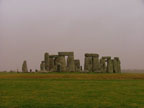 External bank with a diameter near 115 metres was an earthen embankment 2,5 metres wide and in 50-80 centimeters high. In the middle, on the perimeter of the internal bank, It was a ring of 56 small hollows (so-called small hollows of Aubrey). 56 small hollows of Aubrey form a ring of small pits which are carefully marked out and dug, and then – they were filled with the crushed chalk. So the exact placing of 56 small hollows on such large circle shows by itself a sufficient large engineering achievement. An internal bank is the most considerable chalky component of Stonehenge - brightly white, near 6 metres wide, from ridge to ridge it is about 100 metres. The bank is not locked up in the North-west. Approximately, in 30 m in the north-east from the center behind of the bank there is the Heelstone, surrounded with a small ditch. He stands between two parallel earthen banks named Alley.
External bank with a diameter near 115 metres was an earthen embankment 2,5 metres wide and in 50-80 centimeters high. In the middle, on the perimeter of the internal bank, It was a ring of 56 small hollows (so-called small hollows of Aubrey). 56 small hollows of Aubrey form a ring of small pits which are carefully marked out and dug, and then – they were filled with the crushed chalk. So the exact placing of 56 small hollows on such large circle shows by itself a sufficient large engineering achievement. An internal bank is the most considerable chalky component of Stonehenge - brightly white, near 6 metres wide, from ridge to ridge it is about 100 metres. The bank is not locked up in the North-west. Approximately, in 30 m in the north-east from the center behind of the bank there is the Heelstone, surrounded with a small ditch. He stands between two parallel earthen banks named Alley.
Near the internal edge of the bank there are two stones which have got the name of "supporting stones" – sarsenits, quite alike each other neither in a form nor in sizes. In addition, near the internal edge of the bank there are two circle embankments the centers of which and two from supporting stones form a rectangle . Logically to suppose that once there were two supporting stones on both embankments. A ring of the large worked up stones with horizontal cross-bars got the name of the sarseni ring. Once there were 30 stones in the 31metres diametrer sarseni ring. But at present only 17 stones are kept, some of them once fell down and were lifted and set again. 6 cross-bars were kept on their place.
The vertical sides of cross-bars were curved, so they repeated the arc of the circle. The cross-bars of the sarseni ring are leveled on one standard to an approximation of one centimetre, and fixed with bindings which joiners call "nest-tenon" (on a vertical plate there is a "tenon", on a horizontal one there is a "nest"). The cross-beams are also clamped between themselves: their closed sides have ledges and chamfers. The system of these connections gave the considerable firm stability to the construction.
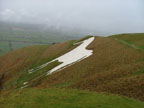 The biggest stones of Stonehenge - are 10 enormous sarsenis, set in pairs in the middle of the main ring. Once there was a cross-beam on each pair of stones, and for description of such construction of three stones a word " trilit" was made up. When one trilit was renovated in 1958, there are three trilitis of five now. The trilitis are disposed in a form of a horseshoe which by its opened end is turned to Alley and Heelstone. Their height reaches 5 metres and their mass is about 50 tons. The trilitis horseshoe tied together with the ring by transverse plates and the ancient Heelstone formed the grandiose stone buildings. They are enormous for modern measures: the high is from 6 to 9 metres, they are approximately 2 metres wide their, mass is from 25 to 50 tons.
The biggest stones of Stonehenge - are 10 enormous sarsenis, set in pairs in the middle of the main ring. Once there was a cross-beam on each pair of stones, and for description of such construction of three stones a word " trilit" was made up. When one trilit was renovated in 1958, there are three trilitis of five now. The trilitis are disposed in a form of a horseshoe which by its opened end is turned to Alley and Heelstone. Their height reaches 5 metres and their mass is about 50 tons. The trilitis horseshoe tied together with the ring by transverse plates and the ancient Heelstone formed the grandiose stone buildings. They are enormous for modern measures: the high is from 6 to 9 metres, they are approximately 2 metres wide their, mass is from 25 to 50 tons.
In the middle of the sarsen ring the remains of another ring of smaller "blue" stones which acquire a blue tint in a humid weather were kept.
There are other blue stones into a trilitis’ horseshoe. At last, there is a block named “Altarny” stone into a horseshoe of blue stones, though it is not exactly in the centre.
At the end of the 18th century for the first time they paid a regard to that the ax of Stonehenge is oriented to a Sun rise point on the day of the summer solstice.
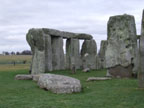 In the middle of the 19-th century they discovered that supporting stones had an astronomic orientation too.
The drawn line through the supporting stones, also shows on the Sunrise point on the day of the summer solstice.
It was found out in the middle of the 20th century that supporting stones showed the point of the Moon rising.
In the middle of the 19-th century they discovered that supporting stones had an astronomic orientation too.
The drawn line through the supporting stones, also shows on the Sunrise point on the day of the summer solstice.
It was found out in the middle of the 20th century that supporting stones showed the point of the Moon rising.
The Moon moves on the sky a complicated way. For 28 days the points of Moon risings and Moon-sets do the cycle of motion on the horizon, like, the Sun does it during a year. Besides that, the arc of the horizon, got with the points of Sunrise and sunset, cyclicly changes with a period in 18,6 years. The period, when the points of Moonrise and Moonset are divided by a maximal arc, is named "high Moon", and the opposite period – is named "low Moon". The ability to distinguish the phases of this cycle, named by astronomers "metons", is important to foresee Sun and moon eclipses.
The line drawn across certain stones shows on the point of the southern rising of "high" Moon. And the line, drawn across these stones in the opposite direction, shows the point of the northest set of "high" Moon.
 The special feature of the location of this megalitic complex is the fact that only on latitudes, very closely to the latitude of Stonehenge, the directions to the Sun rise point on the day of summer solstice and to the point of the rising of "high" Moon form a right angle. But in fact these directions are laid in the location of the supporting stones which form a rectangle. Besides that, the lengths of its sides reflect the proportions of Pyphagor’s triangle with the correlation of the sides 5:12:13 - 25+144=169. The length of the large side of the rectangle of the supporting stones actually are equal to the distance between the center of the ring of Aubrey and Heelstone. And the small holes of Aubrey could be utillized as the clock which measured off the periods of Lunar and Solar eclipses.
The special feature of the location of this megalitic complex is the fact that only on latitudes, very closely to the latitude of Stonehenge, the directions to the Sun rise point on the day of summer solstice and to the point of the rising of "high" Moon form a right angle. But in fact these directions are laid in the location of the supporting stones which form a rectangle. Besides that, the lengths of its sides reflect the proportions of Pyphagor’s triangle with the correlation of the sides 5:12:13 - 25+144=169. The length of the large side of the rectangle of the supporting stones actually are equal to the distance between the center of the ring of Aubrey and Heelstone. And the small holes of Aubrey could be utillized as the clock which measured off the periods of Lunar and Solar eclipses.

 Map coordinates
Map coordinates Area Calculator
Area Calculator 